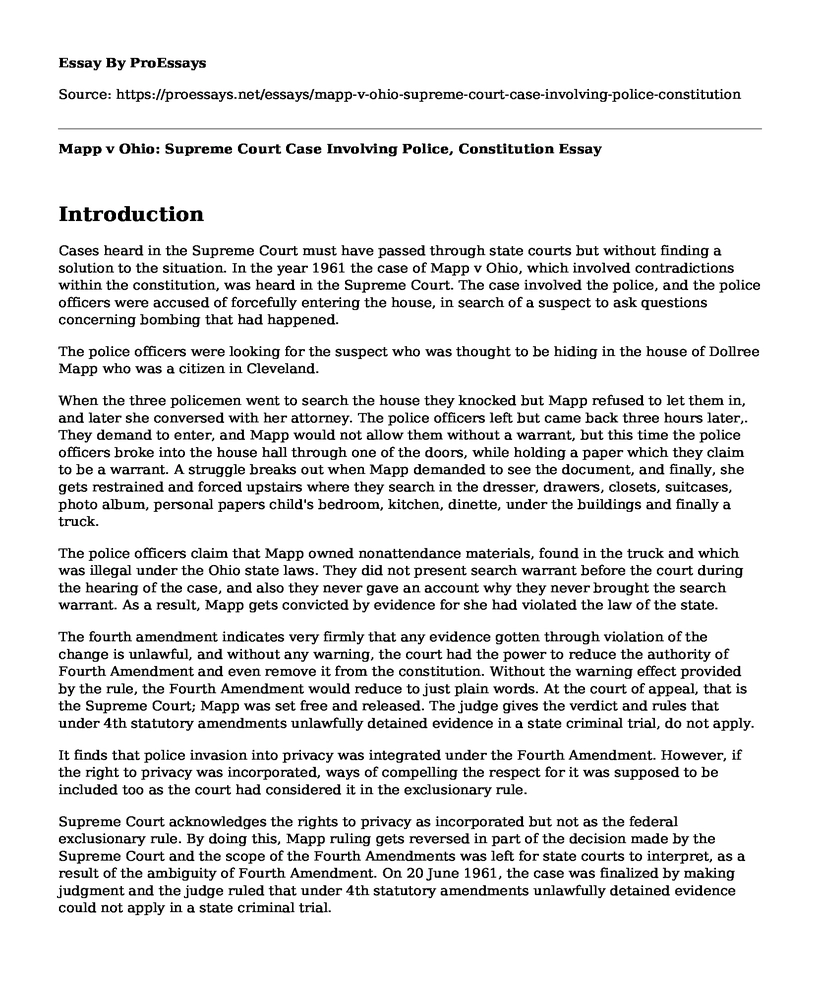Introduction
Cases heard in the Supreme Court must have passed through state courts but without finding a solution to the situation. In the year 1961 the case of Mapp v Ohio, which involved contradictions within the constitution, was heard in the Supreme Court. The case involved the police, and the police officers were accused of forcefully entering the house, in search of a suspect to ask questions concerning bombing that had happened.
The police officers were looking for the suspect who was thought to be hiding in the house of Dollree Mapp who was a citizen in Cleveland.
When the three policemen went to search the house they knocked but Mapp refused to let them in, and later she conversed with her attorney. The police officers left but came back three hours later,. They demand to enter, and Mapp would not allow them without a warrant, but this time the police officers broke into the house hall through one of the doors, while holding a paper which they claim to be a warrant. A struggle breaks out when Mapp demanded to see the document, and finally, she gets restrained and forced upstairs where they search in the dresser, drawers, closets, suitcases, photo album, personal papers child's bedroom, kitchen, dinette, under the buildings and finally a truck.
The police officers claim that Mapp owned nonattendance materials, found in the truck and which was illegal under the Ohio state laws. They did not present search warrant before the court during the hearing of the case, and also they never gave an account why they never brought the search warrant. As a result, Mapp gets convicted by evidence for she had violated the law of the state.
The fourth amendment indicates very firmly that any evidence gotten through violation of the change is unlawful, and without any warning, the court had the power to reduce the authority of Fourth Amendment and even remove it from the constitution. Without the warning effect provided by the rule, the Fourth Amendment would reduce to just plain words. At the court of appeal, that is the Supreme Court; Mapp was set free and released. The judge gives the verdict and rules that under 4th statutory amendments unlawfully detained evidence in a state criminal trial, do not apply.
It finds that police invasion into privacy was integrated under the Fourth Amendment. However, if the right to privacy was incorporated, ways of compelling the respect for it was supposed to be included too as the court had considered it in the exclusionary rule.
Supreme Court acknowledges the rights to privacy as incorporated but not as the federal exclusionary rule. By doing this, Mapp ruling gets reversed in part of the decision made by the Supreme Court and the scope of the Fourth Amendments was left for state courts to interpret, as a result of the ambiguity of Fourth Amendment. On 20 June 1961, the case was finalized by making judgment and the judge ruled that under 4th statutory amendments unlawfully detained evidence could not apply in a state criminal trial.
Conclusion
In conclusion, the Supreme Court ruling was fair. Ohio laws were inconsistent with the rights of free thought and expression that is assured by the Fourteen Amendments. The police invaded a person's home unlawfully.
Works Cited
Enos, Ryan D., Anthony Fowler, and Christopher S. Havasy. "The Negative Effect Fallacy: A Case Study of Incorrect Statistical Reasoning by Federal Courts." Journal of Empirical Legal Studies 14.3 (2017): 618-647.
Slobogin, Christopher. "8. A comparative perspective on the exclusionary rule in search and seizure cases." Comparative Criminal Procedure (2016): 280.
Jones, Russell L. "Terry v. Ohio: Its Failure, Immoral Progeny, and Racial Profiling." Idaho L. Rev. 54 (2018): 511.
Cite this page
Mapp v Ohio: Supreme Court Case Involving Police, Constitution. (2023, Jan 03). Retrieved from https://proessays.net/essays/mapp-v-ohio-supreme-court-case-involving-police-constitution
If you are the original author of this essay and no longer wish to have it published on the ProEssays website, please click below to request its removal:
- History of US Law Enforcement Essay
- Liberalism: Its Origin and Role Essay
- Essay Sample on DNA Assessment
- Literary Analysis Essay on Letter From Birmingham Jail
- Essay Sample on Cyber Attacks: 3 Major Threats from Nation-States, Cybercriminals and Insiders
- Research Paper on Cold War: A Historical Analysis of its Causes and Effects
- Essay on the Ethical Dilemmas of Border Patrol Officers: Gonzalez and La Santa Cecilia's Perspectivet







